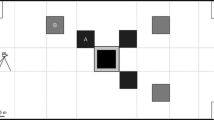Abstract
Field data were collected on a free ranging population of vervet monkeys (Cercopithecus aethiops sabaeus) on St. Kitts to test four hypotheses relating cover, risk of predation, and food density to interindividual distance. The results indicated that when food was not a factor, interindividual distance was positively related to the amount of cover in the immediate environment, and therefore to risk of predation. When cover was held constant, distance was inversely related to food density. When the minimum distance for optimal foraging was greater than that required for safety, a compromise distance intermediate between the two predicted values was observed. Cover and food density also predicted the inverse relationship found between age-sex class and interindividual distance. Implications of the above in relation to interindividual competition are discussed.
Similar content being viewed by others
References
Altmann, S. A., 1974. Baboons, space, time, and energy.Amer. Zool., 14: 221–248.
Ashton, E. H., 1960. The degree and pattern of differences in the cranial dimensions of the St. Kitts green monkey.Proc. Royal Society, 151: 563–583.
Brown, J. L., 1964. The evolution of diversity in avian territorial systems.Wilson Bull., 76: 160–169.
Clutton-Brock, T. H., 1974. Primate social organization and ecology.Nature, 250: 539–542.
Crook, J. H., 1965. The adaptive significance of avian social organization.Symp. zool. Soc. Lond., 14: 181–218.
————, 1972. Sexual selection, dimorphism, and social organization in the primates. In:Sexual Selection and the Descent of Man,B. G. Campbell (ed.), Aldine, Chicago, pp. 231–281.
————, 1968. Ecological and behavioral contrasts between sympatric ground dwelling primates in Ethiopia.Folia primat., 8: 192–227.
————, 1976. Mammalian social systems: structure and function.Anim. Behav., 24: 261–274.
————, 1966. Evolution of primate societies.Nature, 210: 1200–1203.
DeVore, I. &S. L. Washburn, 1963. Baboon ecology and human evolution. In:African Ecology and Human Evolution,F. C. Howell &F. Bourliére (eds.), Aldine, Chicago pp. 335–367.
Fairbanks, L. A., in prep. Interindividual distance in the St. Kitts vervet: a comparison of field and enclosure.
Gartlan, J. S., 1972. Influences of phylogeny and ecology on variations in the group organization of primates.Symp. 4th Int. Congr. Primat., 1: 88–101.
————, 1968. Ecology and social variability inCercopithecus aethiops andCercopithecus mitis. In:Primates: Studies in Adaptation and Variability,P. C. Jay (ed.), Holt, Rinehart, & Winston, New York, pp. 253–292.
Goss-Custard, J. D., R. I. M. Dunbar, &F. P. G. Aldrich-Blake, 1972. Survival, mating, and rearing strategies in the evolution of primate social structure.Folia primat., 17: 1–19.
Horn, H. S., 1968. The adaptive significance of colonial nesting in the Brewer's blackbird (Euphagus cyanocephalus).Ecology, 49: 682–694.
Kerlinger, F. N. &E. J. Pedhazur, 1973.Multiple Regression in Behavioral Research. Holt, Rinehart, & Winston, New York.
Kummer, H., 1968.Social Organization of Hamadryas Baboons. Univ. of Chicago Press, Chicago.
————, 1971a.Primate Societies: Group Techniques of Ecological Adaptations. Aldine-Atherton, Chicago.
————, 1971b. Spacing mechanisms in social behavior. In:Man and Beast,Dillon Eisenberg &Dillon Ripley (eds.), Smithsonian Inst. Press, Washington, D. C., pp. 220–234.
McGuire, M. T., 1974. The St. Kitts vervet.Contributions to Primatology, 1: 1–199.
Poirier, F. E., 1972. The St. Kitts green monkey (Cercopithecus aethiops sabaeus). Ecology, population dynamics, and selected behavioral traits.Folia primat., 17: 20–55.
Richards, A., 1974. Intra-specific variations in the social organization and ecology ofPropithecus verreauxi.Folia primat., 22: 178–207.
Sade, D. W. &R. W. Hildrech, 1965. Notes on the green monkey (Cercopithecus aethiops sabaeus) on St. Kitts, West Indies.Carib. J. Sci., 5: 67–79.
Struhsaker, T. T., 1967. Behavior of vervet monkeys (Cercopithecus aethiops).Univ. Calif. Publ. Zool., 1–64.
————, 1969. Correlates of ecology and social organization among African cercopithecines.Folia primat., 11: 86–118.
Vine, I., 1971. The risk of visual detection and pursuit by a predator and the selective advantage of flocking behavior.J. Theor. Biol., 30: 405–422.
Wilson, E. O., 1975.Sociobiology: A New Synthesis. Harvard Univ. Press, Cambridge, Mass.
Author information
Authors and Affiliations
About this article
Cite this article
Fairbanks, L.A., Bird, J. Ecological correlates of interindividual distance in the St. Kitts veret (Cercopithecus aethiops sabaeus). Primates 19, 605–614 (1978). https://doi.org/10.1007/BF02373629
Received:
Accepted:
Issue Date:
DOI: https://doi.org/10.1007/BF02373629




